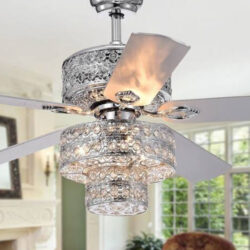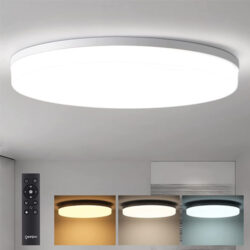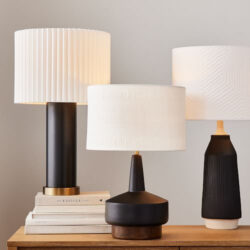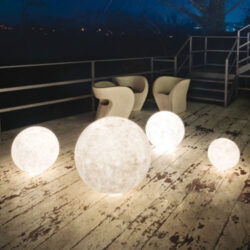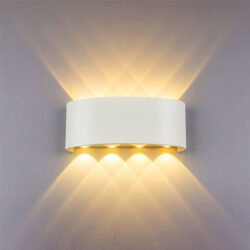Lighting & Ceiling Fans
Cordlesspowertools Canada Online stores have a wide range of Lighting & Ceiling Fans Products that are available in different types and prices. Popular brands like Bosch, Dewalt, Hitachi, Dongcheng, Cumi, KPT, Ferm, Black Decker, Makita, Jon Bhandari, Ken, Metabo, Bullet, Planet Power, Stanley, Maktec, Ralli Wolf, AOG, Falcon, Hit-Min, IDeal, Eastman, Fein, Electrex, Craftsman, AEG, Zogo, Xtra Power, DCA, Yuri have a vast range of models available with different designs and functionalities. You can easily browse through the products, compare them and choose the one that best fits your needs.
Lighting & Ceiling Fans
Lighting and ceiling fans play integral roles in enhancing the functionality and aesthetics of any living space. Its diverse range of fixtures and designs, serves not only as a practical necessity but also as a powerful tool for setting the ambiance and mood of a room. From the warm, inviting glow of pendant lights in the dining area to the focus brilliance of track lighting in a workspace, the right lighting can transform the atmosphere of a room.
Whether you prefer the timeless elegance of chandeliers, the sleek modernity of recessed lighting, or the rustic charm of wall sconces, there's a lighting solution for every taste and style. Ceiling fans, on the other hand, are versatile appliances that offer both comfort and energy efficiency. In the sweltering heat of summer, ceiling fans provide a welcome breeze, helping to cool down a room and reduce the reliance on air conditioning, thereby lowering energy costs.
When it comes to purchasing lighting and ceiling fans, it's essential to consider both functionality and style to create a harmonious and comfortable living space. Lighting fixtures come in a vast array of designs, sizes, and types, each serving a unique purpose. Start by identifying the specific lighting needs for each room.
Types of Lighting:
Chandeliers:
Chandeliers are elegant and ornate light fixtures that are often suspend from the ceiling. They come in various designs, from traditional crystal chandeliers to modern and minimalist styles. Chandeliers are often use as focal points in grand entrances, dining rooms, and formal living spaces.
Pendant Lights:
Pendant lights are single light fixtures suspend by a cord, chain, or rod. They come in a wide range of sizes, shapes, and materials, making them versatile for various interior design styles. Pendant lights can be use as task lighting over kitchen islands, dining tables, or as decorative elements in bedrooms and living rooms.
Flush Mount Lights:
Flush mount lights are fixtures that are instal directly against the ceiling, with no gap between the fixture and the ceiling. They provide ambient lighting and are ideal for rooms with low ceilings, as they don't hang down and take up less vertical space.
Recessed Lighting:
Recessed lights, also known as can lights or downlights, are install into the ceiling and provide a clean and streamlin look. They are often use for ambient or task lighting and are commonly found in kitchens, bathrooms, and hallways.
Track Lighting:
Track lighting consists of a track-mount to the ceiling with adjustable light fixtures that can be positione along the track. This type of lighting is versatile and allows you to direct light where it's neede, making it popular for accenting artwork or highlighting specific areas in a room.
Wall Sconces:
Wall sconces are fixtures that are mount on walls to provide both functional and decorative lighting. They come in various designs, including traditional, modern, and industrial styles. Wall sconces are often use in hallways, bedrooms, and bathrooms.
Floor Lamps:
Floor lamps are freestanding light fixtures that can be place anywhere in a room. They come in different heights and styles, providing both ambient and task lighting. Floor lamps are particularly useful for adding lighting to areas without ceiling fixtures or for creating cozy reading nooks.
Table Lamps:
Table lamps are smaller lamps design to sit on tables, desks, or nightstands. They are available in a wide range of shapes, sizes, and materials, serving as both functional lighting and decorative accents.
Now, let's move on to ceiling fans:
Types of Ceiling Fans:
Standard Ceiling Fans: These are the most common type of ceiling fans, featuring multiple blades and a central motor. They are design to provide a comfortable breeze and help with air circulation in a room.
Hugger Ceiling Fans: Hugger fans, also known as low-profile fans, are designed for rooms with low ceilings. They are mount flush against the ceiling and have shorter down rods to maximize headroom.
Energy-Efficient Ceiling Fans: These fans are design with energy-saving features, such as efficient motors and aerodynamic blade designs. They help reduce energy consumption while providing the cooling benefits of a traditional fan.
Outdoor Ceiling Fans: Outdoor fans are built to withstand outdoor conditions, including exposure to moisture and varying temperatures. They are ideal for patios, porches, and covered outdoor spaces.
Remote-Controlled Ceiling Fans: These fans come with remote controls that allow you to adjust the fan speed, direction, and sometimes even the lighting without needing to reach the fan itself.
Smart Ceiling Fans: Smart fans can be controll using smartphones, voice assistants (like Alexa or Google Assistant), or smart home systems. They often have features like adjustable speed, scheduling, and integration with other smart devices.
Dual-Motor Ceiling Fans: These unique fans have two sets of blades and motors, allowing for independent operation. They are often chosen for their distinctive look and increas air circulation capabilities.
Retractable Blade Ceiling Fans: Retractable blade fans have blades that can be extend or retract as need. When not in use, the blades are hidden, giving the fan a more compact and modern appearance.
Lighting Features:
Dimming Capability: Many modern lighting fixtures offer dimming options, allowing you to adjust the brightness of the light to create the desire ambiance.
Color Temperature Control: Some lighting systems allow you to adjust the color temperature of the light, from warm to cool, to match different activities and moods.
Smart Controls: Smart lighting systems can be controll remotely using smartphones or voice commands, offering convenience and energy efficiency.
Energy Efficiency: LED lighting is known for its energy efficiency and long lifespan compar to traditional incandescent bulbs.
Directional Lighting: Certain fixtures like track lights and adjustable pendants offer the ability to direct light precisely where it's need.
Focal and Accent Lighting: Different fixtures are design for accentuating artwork, architectural features, or specific areas in a room.
Benefits:
Ambiance: Lighting plays a crucial role in creating the right ambiance for any space, from warm and cozy to bright and energetic.
Task Illumination: Proper task lighting enhances productivity and safety in areas like kitchens, offices, and reading nooks.
Aesthetics: Lighting fixtures are decorative elements that can contribute to the overall aesthetic of a room and complement its design style.
Energy Savings: Energy-efficient lighting options like LED bulbs can significantly reduce electricity consumption and lower utility bills.
Longevity: LED bulbs have a longer lifespan compare to traditional bulbs, reducing the frequency of replacements.
Customization: With various lighting types and designs, you can customize your lighting setup to match your preferences and needs.
Safety Considerations:
Heat Generation: Some light fixtures can generate heat, so it's important to keep flammable materials away from them.
Electrical Wiring: Proper installation and maintenance of wiring are crucial to prevent electrical hazards. Always hire a qualified electrician for installations.
Fixture Placement: Be mindful of placing fixtures away from water sources and ensuring that they are securely mount to avoid accidents.
Bulb Wattage: Ensure that you're using the correct wattage bulbs for each fixture to prevent overheating and potential fire hazards.
Child Safety: Keep cords and wires out of reach of children, and use childproof covers on outlets if needed.
Ceiling Fans Features:
Multiple Speeds: Ceiling fans offer various speed settings to control the airflow and maintain comfort in different seasons.
Reversible Blades: Many fans have reversible blades, allowing you to change the direction of the airflow to cool or warm a room.
Integrated Lighting: Some ceiling fans come with integrat light fixtures, providing both cooling and illumination in one unit.
Remote Control: Remote-controlled fans allow you to adjust speed, direction, and sometimes lighting from a distance.
Smart Control: Smart ceiling fans can be controll through smartphones or voice assistants, offering convenience and energy management.
Benefits:
Cooling Effect: Ceiling fans create a wind chill effect, making you feel cooler even without lowering the room's temperature.
Energy Efficiency: Running a ceiling fan in conjunction with an air conditioner can allow you to set the thermostat higher while maintaining comfort.
Year-Round Use: Reversible fans can help distribute warm air downward during colder months, improving heating efficiency.
Circulation and Ventilation: Ceiling fans improve air circulation, reducing stuffiness and odors in enclosed spaces.
Cost Savings: Ceiling fans use less energy than air conditioning units, contributing to lower energy bills.
Safety Considerations:
Installation: Proper installation is critical for safety. Fans should be securely mount to a suitable ceiling structure.
Blade Clearance: Ensure that the fan blades have sufficient clearance from walls and other objects to avoid obstruction.
Maintenance: Regular maintenance, such as cleaning the blades and checking for wobbling, helps prevent accidents.
Electrical Safety: Like with lighting, proper electrical installation by a qualified electrician is crucial for fan safety.
Children and Pets: Be cautious with children and pets around ceiling fans to prevent accidents from contact with moving blades.
Lighting & Ceiling Fans
Lighting and ceiling fans play integral roles in enhancing the functionality and aesthetics of any living space. Its diverse range of fixtures and designs, serves not only as a practical necessity but also as a powerful tool for setting the ambiance and mood of a room. From the warm, inviting glow of pendant lights in the dining area to the focus brilliance of track lighting in a workspace, the right lighting can transform the atmosphere of a room.
Whether you prefer the timeless elegance of chandeliers, the sleek modernity of recessed lighting, or the rustic charm of wall sconces, there's a lighting solution for every taste and style. Ceiling fans, on the other hand, are versatile appliances that offer both comfort and energy efficiency. In the sweltering heat of summer, ceiling fans provide a welcome breeze, helping to cool down a room and reduce the reliance on air conditioning, thereby lowering energy costs.
When it comes to purchasing lighting and ceiling fans, it's essential to consider both functionality and style to create a harmonious and comfortable living space. Lighting fixtures come in a vast array of designs, sizes, and types, each serving a unique purpose. Start by identifying the specific lighting needs for each room.
Types of Lighting:
Chandeliers:
Chandeliers are elegant and ornate light fixtures that are often suspend from the ceiling. They come in various designs, from traditional crystal chandeliers to modern and minimalist styles. Chandeliers are often use as focal points in grand entrances, dining rooms, and formal living spaces.
Pendant Lights:
Pendant lights are single light fixtures suspend by a cord, chain, or rod. They come in a wide range of sizes, shapes, and materials, making them versatile for various interior design styles. Pendant lights can be use as task lighting over kitchen islands, dining tables, or as decorative elements in bedrooms and living rooms.
Flush Mount Lights:
Flush mount lights are fixtures that are instal directly against the ceiling, with no gap between the fixture and the ceiling. They provide ambient lighting and are ideal for rooms with low ceilings, as they don't hang down and take up less vertical space.
Recessed Lighting:
Recessed lights, also known as can lights or downlights, are install into the ceiling and provide a clean and streamlin look. They are often use for ambient or task lighting and are commonly found in kitchens, bathrooms, and hallways.
Track Lighting:
Track lighting consists of a track-mount to the ceiling with adjustable light fixtures that can be positione along the track. This type of lighting is versatile and allows you to direct light where it's neede, making it popular for accenting artwork or highlighting specific areas in a room.
Wall Sconces:
Wall sconces are fixtures that are mount on walls to provide both functional and decorative lighting. They come in various designs, including traditional, modern, and industrial styles. Wall sconces are often use in hallways, bedrooms, and bathrooms.
Floor Lamps:
Floor lamps are freestanding light fixtures that can be place anywhere in a room. They come in different heights and styles, providing both ambient and task lighting. Floor lamps are particularly useful for adding lighting to areas without ceiling fixtures or for creating cozy reading nooks.
Table Lamps:
Table lamps are smaller lamps design to sit on tables, desks, or nightstands. They are available in a wide range of shapes, sizes, and materials, serving as both functional lighting and decorative accents.
Now, let's move on to ceiling fans:
Types of Ceiling Fans:
Standard Ceiling Fans: These are the most common type of ceiling fans, featuring multiple blades and a central motor. They are design to provide a comfortable breeze and help with air circulation in a room.
Hugger Ceiling Fans: Hugger fans, also known as low-profile fans, are designed for rooms with low ceilings. They are mount flush against the ceiling and have shorter down rods to maximize headroom.
Energy-Efficient Ceiling Fans: These fans are design with energy-saving features, such as efficient motors and aerodynamic blade designs. They help reduce energy consumption while providing the cooling benefits of a traditional fan.
Outdoor Ceiling Fans: Outdoor fans are built to withstand outdoor conditions, including exposure to moisture and varying temperatures. They are ideal for patios, porches, and covered outdoor spaces.
Remote-Controlled Ceiling Fans: These fans come with remote controls that allow you to adjust the fan speed, direction, and sometimes even the lighting without needing to reach the fan itself.
Smart Ceiling Fans: Smart fans can be controll using smartphones, voice assistants (like Alexa or Google Assistant), or smart home systems. They often have features like adjustable speed, scheduling, and integration with other smart devices.
Dual-Motor Ceiling Fans: These unique fans have two sets of blades and motors, allowing for independent operation. They are often chosen for their distinctive look and increas air circulation capabilities.
Retractable Blade Ceiling Fans: Retractable blade fans have blades that can be extend or retract as need. When not in use, the blades are hidden, giving the fan a more compact and modern appearance.
Lighting Features:
Dimming Capability: Many modern lighting fixtures offer dimming options, allowing you to adjust the brightness of the light to create the desire ambiance.
Color Temperature Control: Some lighting systems allow you to adjust the color temperature of the light, from warm to cool, to match different activities and moods.
Smart Controls: Smart lighting systems can be controll remotely using smartphones or voice commands, offering convenience and energy efficiency.
Energy Efficiency: LED lighting is known for its energy efficiency and long lifespan compar to traditional incandescent bulbs.
Directional Lighting: Certain fixtures like track lights and adjustable pendants offer the ability to direct light precisely where it's need.
Focal and Accent Lighting: Different fixtures are design for accentuating artwork, architectural features, or specific areas in a room.
Benefits:
Ambiance: Lighting plays a crucial role in creating the right ambiance for any space, from warm and cozy to bright and energetic.
Task Illumination: Proper task lighting enhances productivity and safety in areas like kitchens, offices, and reading nooks.
Aesthetics: Lighting fixtures are decorative elements that can contribute to the overall aesthetic of a room and complement its design style.
Energy Savings: Energy-efficient lighting options like LED bulbs can significantly reduce electricity consumption and lower utility bills.
Longevity: LED bulbs have a longer lifespan compare to traditional bulbs, reducing the frequency of replacements.
Customization: With various lighting types and designs, you can customize your lighting setup to match your preferences and needs.
Safety Considerations:
Heat Generation: Some light fixtures can generate heat, so it's important to keep flammable materials away from them.
Electrical Wiring: Proper installation and maintenance of wiring are crucial to prevent electrical hazards. Always hire a qualified electrician for installations.
Fixture Placement: Be mindful of placing fixtures away from water sources and ensuring that they are securely mount to avoid accidents.
Bulb Wattage: Ensure that you're using the correct wattage bulbs for each fixture to prevent overheating and potential fire hazards.
Child Safety: Keep cords and wires out of reach of children, and use childproof covers on outlets if needed.
Ceiling Fans Features:
Multiple Speeds: Ceiling fans offer various speed settings to control the airflow and maintain comfort in different seasons.
Reversible Blades: Many fans have reversible blades, allowing you to change the direction of the airflow to cool or warm a room.
Integrated Lighting: Some ceiling fans come with integrat light fixtures, providing both cooling and illumination in one unit.
Remote Control: Remote-controlled fans allow you to adjust speed, direction, and sometimes lighting from a distance.
Smart Control: Smart ceiling fans can be controll through smartphones or voice assistants, offering convenience and energy management.
Benefits:
Cooling Effect: Ceiling fans create a wind chill effect, making you feel cooler even without lowering the room's temperature.
Energy Efficiency: Running a ceiling fan in conjunction with an air conditioner can allow you to set the thermostat higher while maintaining comfort.
Year-Round Use: Reversible fans can help distribute warm air downward during colder months, improving heating efficiency.
Circulation and Ventilation: Ceiling fans improve air circulation, reducing stuffiness and odors in enclosed spaces.
Cost Savings: Ceiling fans use less energy than air conditioning units, contributing to lower energy bills.
Safety Considerations:
Installation: Proper installation is critical for safety. Fans should be securely mount to a suitable ceiling structure.
Blade Clearance: Ensure that the fan blades have sufficient clearance from walls and other objects to avoid obstruction.
Maintenance: Regular maintenance, such as cleaning the blades and checking for wobbling, helps prevent accidents.
Electrical Safety: Like with lighting, proper electrical installation by a qualified electrician is crucial for fan safety.
Children and Pets: Be cautious with children and pets around ceiling fans to prevent accidents from contact with moving blades.

